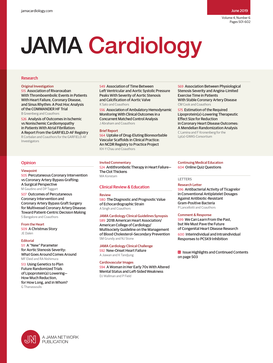收缩压多基因风险评分与氯沙坦反应的实用性
IF 14.8
1区 医学
Q1 CARDIAC & CARDIOVASCULAR SYSTEMS
引用次数: 0
摘要
重要性多基因风险评分(PRS)对血压(BP)降压治疗(AHT)反应的临床效用尚未阐明。目的研究收缩压(SBP)PRS预测AHT反应和明显耐药高血压(aTRH)的能力。高血压相关治疗遗传学(GenHAT)研究是抗高血压和降脂治疗预防心脏病发作试验(ALLHAT)的一项辅助药物基因组研究。ALLHAT 于 1994 年 2 月开始招募 55 岁或 55 岁以上的高血压(HTN)患者,并于 2002 年 3 月完成随访。目前的研究是从随机分配到氯沙坦(3745 人)或利辛普利(2294 人)治疗组的 GenHAT 黑人参与者中抽取一部分人进行的,他们的基因数据可从之前的基因关联研究中获得。当前研究的目的是检查 6 个月内 SBP PRS 与 AHT 反应的相关性,以及检查 SBP PRS 对 aTRH 的预测准确性。主要结果和测量指标主要结果是 6 个月内 SBP(ΔSBP)和舒张压(ΔDBP)的变化。aTRH 的定义是在随访第 3 年时使用 3 种 AHTs 且 HTN 未得到控制,或在随访第 3 年时使用 4 种或更多 AHTs,无论血压如何。根据情况使用 Kruskal-Wallis 或 χ2 检验比较不同 PRS 五分位数的基线人口统计学特征。通过多变量调整线性回归计算出血压反应的最小平方均值,并使用多变量调整逻辑回归计算出 aTRH 的几率比和 95% 的置信区间。在 6 个月的治疗过程中,SBP PRS 从 1 到 5 每增加一个五分位数都会导致血压反应降低。最低五分位数参与者的平均ΔSBP 为 -10.01 mm Hg(95% CI,-11.11 至 -8.90),而中位五分位数参与者的平均ΔSBP 为 -6.57 mm Hg(95% CI,-7.67 至 -5.48)。在 SBP PRS 与利辛普利血压反应之间未观察到任何关联。与中位五分位数的参与者相比,PRS最高五分位数的参与者发生TRH的几率高出67%(几率比为1.67;95% CI为1.19-2.36)。结论和相关性在这项遗传关联研究中,与血压升高的中等遗传风险人群相比,血压升高的遗传风险较低的黑人高血压患者对氯沙坦的反应要高出约 3.5 mm Hg。SBP PRS 还可以识别出治疗耐药高血压风险较高的高血压患者。总之,SBP PRS 具有识别那些可能从氯酞酮中获益更多的人的潜力,但还需要未来的研究来确定 PRS 是否能为高血压患者开始和选择治疗提供信息。本文章由计算机程序翻译,如有差异,请以英文原文为准。
Utility of a Systolic Blood Pressure Polygenic Risk Score With Chlorthalidone Response.
Importance
The clinical utility of polygenic risk scores (PRS) for blood pressure (BP) response to antihypertensive treatment (AHT) has not been elucidated.
Objective
To investigate the ability of a systolic BP (SBP) PRS to predict AHT response and apparent treatment-resistant hypertension (aTRH).
Design, Setting, and Participants
The Genetics of Hypertension Associated Treatments (GenHAT) study was an ancillary pharmacogenomic study to the Antihypertensive and Lipid-Lowering Treatment to Prevent Heart Attack Trial (ALLHAT). ALLHAT, which enrolled participants aged 55 years or older with hypertension (HTN) starting in February 1994, completed follow-up in March 2002. The current study was conducted from a subset of Black GenHAT participants randomized to the treatment groups of either chlorthalidone (n = 3745) or lisinopril (n = 2294), with genetic data available from a prior genetic association study. The current study's objective was to examine the association of the SBP PRS to AHT response over 6 months, as well as to examine the predictive accuracy of the SBP PRS with aTRH. The current analysis took place in February 2023, with additional analyses conducted in July 2024.
Exposure
An SBP PRS (comprising 1 084 157 genetic variants) stratified as quintiles and per SD.
Main Outcomes and Measures
The primary outcome was change in SBP (ΔSBP) and diastolic BP (ΔDBP) over 6 months. aTRH was defined as the use of 3 AHTs with uncontrolled HTN at year 3 of follow-up or taking 4 or more AHTs at year 3 of follow-up, regardless of BP. Baseline demographics were compared across PRS quintiles using Kruskal-Wallis or χ2 tests as appropriate. The least-square means of BP response were calculated through multivariable adjusted linear regression, and multivariable adjusted logistic regression was used to calculate the odds ratios and 95% confidence intervals for aTRH.
Results
Among 3745 Black GenHAT participants randomized to chlorthalidone treatment, median (IQR) participant age was 65 (60-71) years, and 2064 participants (55.1%) were female. Each increasing quintile of the SBP PRS from 1 to 5 was associated with a reduced BP response to treatment over 6 months. Participants in the lowest quintile experienced a mean ΔSBP of -10.01 mm Hg (95% CI, -11.11 to -8.90) compared to -6.57 mm Hg (95% CI, -7.67 to -5.48) for participants in the median quintile. No associations were observed between the SBP PRS and BP response to lisinopril. Participants in the highest PRS quintile had 67% higher odds of aTRH compared to those in the median quintile (odds ratio, 1.67; 95% CI, 1.19-2.36). These associations were independently validated.
Conclusions and Relevance
In this genetic association study, Black individuals with HTN at a lower genetic risk of elevated BP experienced an approximately 3.5 mm Hg-greater response to chlorthalidone compared with those at an intermediate genetic risk of elevated BP. SBP PRS may also identify individuals with HTN harboring a higher risk of treatment-resistant HTN. Overall, SBP PRS demonstrates potential to identify those who may have greater benefit from chlorthalidone, but future research is needed to determine if PRS can inform initiation and choice of treatment among individuals with HTN.
求助全文
通过发布文献求助,成功后即可免费获取论文全文。
去求助
来源期刊

JAMA cardiology
Medicine-Cardiology and Cardiovascular Medicine
CiteScore
45.80
自引率
1.70%
发文量
264
期刊介绍:
JAMA Cardiology, an international peer-reviewed journal, serves as the premier publication for clinical investigators, clinicians, and trainees in cardiovascular medicine worldwide. As a member of the JAMA Network, it aligns with a consortium of peer-reviewed general medical and specialty publications.
Published online weekly, every Wednesday, and in 12 print/online issues annually, JAMA Cardiology attracts over 4.3 million annual article views and downloads. Research articles become freely accessible online 12 months post-publication without any author fees. Moreover, the online version is readily accessible to institutions in developing countries through the World Health Organization's HINARI program.
Positioned at the intersection of clinical investigation, actionable clinical science, and clinical practice, JAMA Cardiology prioritizes traditional and evolving cardiovascular medicine, alongside evidence-based health policy. It places particular emphasis on health equity, especially when grounded in original science, as a top editorial priority.
 求助内容:
求助内容: 应助结果提醒方式:
应助结果提醒方式:


